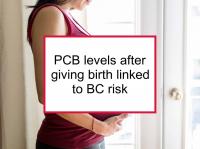Polychlorinated biphenyls (PCBs) are synthetic hydrocarbon compounds that were widely used in the electronics and similar industries beginning in the 1930s. Most PCBs were restricted or banned in the 1970s and 1980s. However they persist in the environment as a result of their resistance to decomposition and their long half-life.
PCBs are endocrine disruptors, which are chemicals that interfere with hormone systems in the body. Most endocrine disruptors suspected of causing breast cancer have estrogenic properties, in other words, they mimic estrogen. However, PCBs have also been shown to promote migration of triple negative breast cancer cells, which are estrogen receptor negative.
PCBs have been shown to enhance the metastatic propensity of breast cancer cells, in part by increasing their migration. Exposure to PCBs has been linked to an increased incidence of breast cancer in population studies, although not all studies are in agreement. Now a new study has reported that elevated levels of PCBs shortly after having given birth (when the breast undergoes changes associated with lactation) are associated with increased risk of premenopausal breast cancer.
Sources of exposure to PCBs
PCBs tend to accumulate in predatory fish and shellfish, which are the main sources of exposure for U.S. residents. Farmed fish tend to have higher levels of PCBs than their wild caught counterparts. Female fish eliminate PCBs from their bodies in their roe, which can lead to relatively high levels in caviar from some regions such as the Black Sea. PCBs are also found in dairy products (especially milk and butter) and animal fat.
High quality fish oil supplements normally are not a significant source of PCBs. However, cod liver oil can have high levels. Lactation is the most important elimination route of PCBs in women, which implies that pregnant and nursing mothers should avoid most fish and shellfish. Most U.S. residents do not have significant exposure to PCBs.
New research finds postpartum PCB levels linked to risk
The study referenced at the beginning of this news article was designed to test the hypothesis that elevated levels of PCBs in mothers shortly after having given birth are associated with increased risk of premenopausal breast cancer. It has been established that the breast is more susceptible to toxins during certain periods, including the prenatal period, puberty, pregnancy, and postpartum. To conduct the study, the authors analyzed stored postpartum serum samples that had been collected between 1959 and 1967 for PCBs. The samples were collected an average of 17 years before breast cancer diagnosis (average age of diagnosis: 43 years). The study included 112 breast cancer cases matched to cancer-free controls based on birth year.
Strong associations with breast cancer risk were found for three PCBs: PCB 167, PCB 187 and PCB 203. Both PCB 167 and PCB 187 were actually associated with a somewhat lower risk of breast cancer. On the other hand, PCB 203 was associated with 6.3 times the risk of breast cancer (comparing women in the highest fourth to the lowest fourth of PCB level). The estimated net association of PCB exposure was a nearly threefold increase in risk among women with a higher level of PCB 203 than the sum of their PCB 167 and PCB 187 levels. Note that PCB exposure shortly after having given birth most likely also represents exposure during pregnancy, when changes in the breast in preparation for lactation are also occurring.
The authors comment that it remains unclear whether individual differences in PCB exposure, response to exposure, or both explain the breast cancer risk patterns observed.
